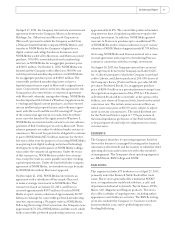Barnes and Noble 2013 Annual Report Download - page 21
Download and view the complete annual report
Please find page 21 of the 2013 Barnes and Noble annual report below. You can navigate through the pages in the report by either clicking on the pages listed below, or by using the keyword search tool below to find specific information within the annual report.
Depreciation and amortization increased $4.0 million, or
1.8%, to $232.7 million in fiscal 2012 from $228.6 million
in fiscal 2011. This increase was primarily attributable to
amortization of intellectual property assets purchased from
Borders and additional capital expenditures.
Operating Profit (Loss)
52 weeks ended
Dollars in thousands
April 28,
2012 % Sales
April 30,
2011 % Sales
B&N Retail $ 161,136 3.3% $ 102,592 2.1%
B&N College 70,604 4.0% 70,298 4.0%
NOOK (286,343) (53.8)% (229,689) (78.2)%
Total Operating Loss $ (54,603) (0.8)% $ (56,799) (0.8)%
The Company’s consolidated operating loss decreased $2.2
million, or 3.9%, to an operating loss of $54.6 million in
fiscal 2012 from an operating loss of $56.8 million in fiscal
2011. This decrease was due to the matters discussed above.
Interest Expense, Net and Amortization of Deferred
Financing Fees
52 weeks ended
Dollars in thousands
April 28,
2012
April 30,
2011
% of
Change
Interest Expense, Net and
Amortization of Deferred
Financing Fees $ 35,304 $ 57,350 (38.4)%
Net interest expense and amortization of deferred financ-
ing fees decreased $22.0 million, to $35.3 million in fiscal
2012 from $57.3 million in fiscal 2011. This decrease was
primarily due to more favorable rates on the 2011 Amended
Credit Facility under the Company’s credit facility, lower
borrowings driven by the Liberty investment, payment of
a short-term note in December 2010 and a $6.6 million
write-off of deferred financing fees in the prior fiscal year
related to the amendment of the Company’s credit facility.
Income Taxes
52 weeks ended
Dollars in thousands
April 28,
2012
Effective
Rate
April 30,
2011
Effective
Rate
Income Taxes $ (25,067) 27.9% $ (45,276) 39.7%
Income tax benefit in fiscal 2012 was $25.1 million compared
with income tax benefit of $45.3 million in fiscal 2011. The
Company’s effective tax rate decreased to 27.9% in fiscal
2012 compared with 39.7% in fiscal 2011. The lower effective
tax rate in fiscal 2012 was due primarily to additions to the
tax reserve and a permanent tax charge related to current
and prior year compensation.
Net Loss Attributable to Noncontrolling Interests
Net loss attributable to noncontrolling interests was $0.04
million in fiscal 2011 and relates to the 50% outside inter-
est in Begin Smart LLC (Begin Smart).
During fiscal 2011, the Company purchased the remaining
50% outside interest in Begin Smart for $0.3 million. 100%
of Begin Smart results of operations for the period subse-
quent to the Begin Smart acquisition date were included in
the consolidated financial statements.
Net Earnings (Loss) Attributable to Barnes & Noble, Inc.
52 weeks ended
Dollars in thousands
April 28,
2012
Diluted
EPS
April 30,
2011
Diluted
EPS
Net Loss Attributable
to Barnes & Noble, Inc. $ (64,840) $ (1.34) $ (68,836) $ (1.22)
As a result of the factors discussed above, the Company
reported a consolidated net loss of $64.8 million (or $1.34
per diluted share) during fiscal 2012, compared with
consolidated net loss of $68.8 million (or $1.22 per diluted
share) during fiscal 2011.
SEASONALITY
The B&N Retail business, like that of many retailers, is sea-
sonal, with the major portion of sales and operating profit
realized during its third fiscal quarter, which includes the
holiday selling season.
The B&N College business is highly seasonal, with the
major portion of sales and operating profit realized during
the second and third fiscal quarters, when college students
generally purchase and rent textbooks for the upcoming
semesters. Revenues from textbook rentals, which primarily
occur at the beginning of the semester, are recognized over
the rental period.
The NOOK business, like that of many technology com-
panies, is impacted by the launch of new products and the
promotional efforts to support those new products, as well
as the traditional retail holiday selling seasonality.
LIQUIDITY AND CAPITAL RESOURCES
The primary sources of the Company’s cash are net cash
flows from operating activities, funds available under its
senior credit facility, cash received and committed in the
formation of NOOK Media, cash received from the Pearson
strategic investment in NOOK Media and short-term
vendor financing.
The Company’s cash and cash equivalents were $160.5 mil-
lion as of April 27, 2013, compared with $54.1 million as of
April 28, 2012.
2013 Annual Report 19
























